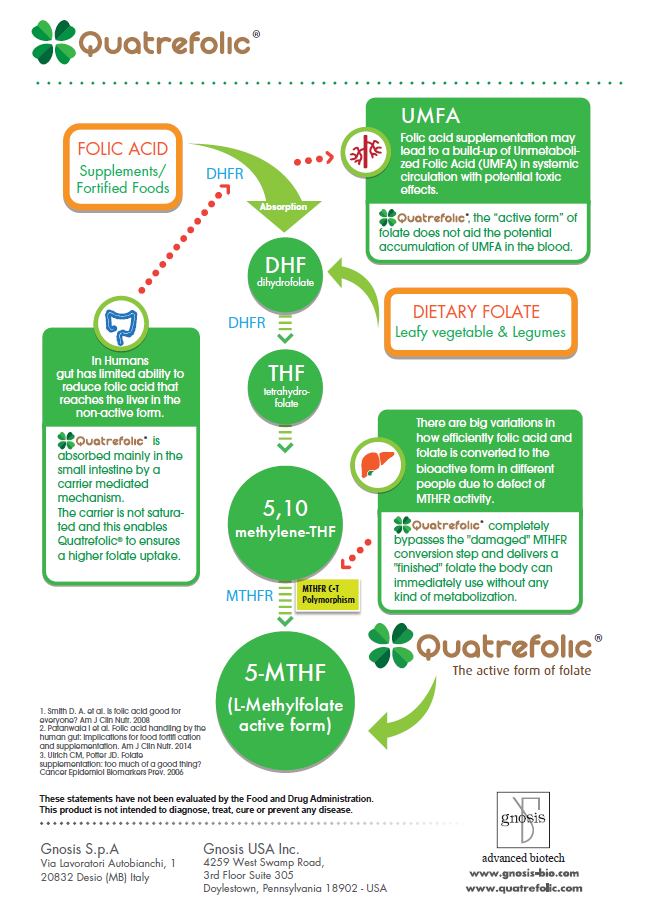Now you can find a clear chart that explains the folate metabolic pathway, from folic acid to active 5-methyltetrahydrofolate (5-MTHF)! As a matter of fact folic acid must be converted to an active form before it is used by the body.
Step by step, discover the benefits that Gnosis’ Quatrefolic® offers VS Folic Acid!
Quatrefolic® is the glucosamine salt of (6S)-5-methyltetrahydrofolate and is structurally analogous to the reduced and active form of folic acid, so Quatrefolic® completely bypasses the conversion step and delivers a “finished” folate the body can immediately use without any kind of metabolization.
Impaired Folic Acid Metabolism and MTHFR Polymorphism
Methylenetetrahydrofolate reductase (MTHFR) is one of the most important enzymes in human physiology, deficiencies in production or function of this enzyme have been associated with increased risk of chronic disease states. Some individuals, due to their unique genetic patterns and expression, have polymorphic forms of this enzyme and do not produce adequate or effective MTHFR.
MTHFR converts folic acid/ food folates into the activated form, (6S)-5-MTHF or 5-methyltetrahydrofolate.
Genetic variations of this enzyme may impair MTHFR activity from 55% to 70% efficiency compared to a normal MTHFR enzyme. MTHFR polymorphisms are estimated to occur in up to 40% of the world population (1, 2, 3).
Based on the high prevalence of MTHFR genetic polymorphisms in the general population and concerns about reduced enzymatic activity, the worldwide scientific community is focusing newer research in this area, suggesting even more to replace folic acid supplementation with the biological active form (6S)-5-methyltetrahydrofolate, such as Quatrefolic®, for preventing folate-related pathology.
The debate about folic acid vs (6S)-5-MTHF also extends to consumers which are even more aware about the deep implications of MTHFR polymorphism in supporting their health. Consumers are also concerned about the potential clinical implications and adverse effects of high dose of folic acid assumed unconsciously due to uncontrolled consumption fortified foods.
Several studies have reported an increase in serum of unmetabolized folic acid (UMFA) levels since the implementation of folic acid fortification. A study published in 2014 clearly showed that 86% of folic acid in the hepatic portal vein is unmetabolized, whilst almost all of the natural folate was converted correctly (3,4).
Variability in the presence or persistence of UMFA in the population suggests that it may be accumulated in the blood as a consequence of different conditions, such as the impairment, and/or the slackness of the folic acid reduction pathway to the 5-methyltetrahydrofolate (genetic polymorphism), and the overdosing effect due to uncontrolled folic acid intake
Know more about Impaired Folic Acid Metabolism and MTHFR Polymorphism
Lorena Carboni
Product Support Specialist of Gnosis SpA
For more information contact:
marketing@gnosis-bio.com






